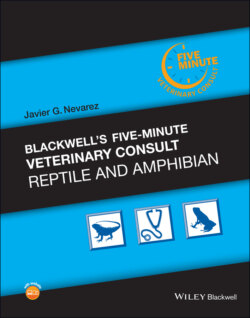Читать книгу Blackwell's Five-Minute Veterinary Consult: Reptile and Amphibian - Javier G. Nevarez - Страница 30
SPECIAL SENSES
ОглавлениеThe eyes of reptiles can be quite varied. Reptiles have avascular retinas. Scleral ossicles are present in lizards and chelonians but absent in other reptiles. Reptiles have a conus papillary that is analogous to the pecten of birds. Most lizards have a nasolacrimal duct, but eyelids may be absent, as in the case of some gecko species. Chelonians lack a nasolacrimal duct and have a predominance of cones. Snakes have a nasolacrimal duct that drains the subspectacular space, but they lack a nasolacrimal gland. They are the only group to have scleral cartilage. The number of rods and cones in snakes will vary by species. Although it looks transparent, the spectacle of snakes is very vascular.
A vomeronasal organ is present in tuataras, lizards, and snakes, but absent in crocodilians. Its presence is debated in chelonians. Pit organs are openings in the maxillary and/or mandible of boas, pythons, and pit vipers, which serve to provide infrared detection of environmental cues. There are free nerve endings within the pits or scales, and this is thought to be a very sensitive system.
